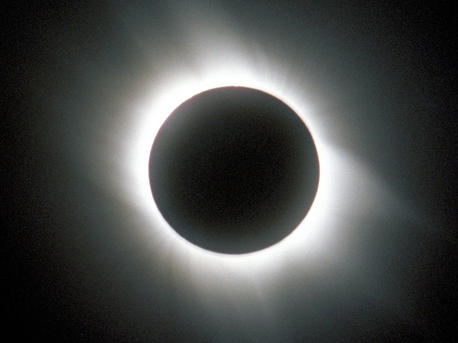The Sun's atmosphere
Does the Sun have a surface?
"Of course," we might answer, "what a question!" However, we should also consider that our Sun - like all other stars - is a ball of hot gas. This gas ball, with a diameter of 0.9 million miles, is held together by gravity alone. This means that the Sun does not have a firm surface.
 © Ralf Künnemann (CC-BY-SA 2.5) |
This photograph shows the Sun's corona, which only becomes visible to the unaided observer during a total solar eclipse. Then, the light from the photosphere is fully masked by the Moon.
Nevertheless, the Sun appears to us as a shining sphere with a sharp edge. The reason for this is that the sunlight we observe without any aids originates in a relatively thin layer. This layer, known as the photosphere, is only a few hundred miles thick. It therefore makes sense to talk about the visible surface of the Sun.
The various layers of the Sun's atmosphere
The Sun's surface would no longer look at all smooth and round if our eyes could perceive ultraviolet radiation and X-rays. In these radiation ranges it becomes clear how the solar magnetic field continuously changes the shape of the Sun's atmosphere: features in motion on the Sun's surface, explosions of radiation and streams of matter which speed out into space for tens of thousand of miles. This layer of the Sun’s atmosphere, which can be observed with ultraviolet and X-ray telescopes, lies above the photosphere and is called the chromosphere.
The outermost layer of the Sun's atmosphere, the corona, can only be seen with the naked eye during a total solar eclipse. Then, the light from the photosphere is fully masked by the Moon. The corona is a 'crown of rays' with a temperature of over a million degrees Celsius, which usually has an asymmetric form – depending on the Sun's activity.
German Aerospace Center
The various layers of the Sun's atmosphere
The Sun's surface would no longer look at all smooth and round if our eyes could perceive ultraviolet radiation and X-rays. In these radiation ranges it becomes clear how the solar magnetic field continuously changes the shape of the Sun's atmosphere: features in motion on the Sun's surface, explosions of radiation and streams of matter which speed out into space for tens of thousand of miles. This layer of the Sun’s atmosphere, which can be observed with ultraviolet and X-ray telescopes, lies above the photosphere and is called the chromosphere.
The outermost layer of the Sun's atmosphere, the corona, can only be seen with the naked eye during a total solar eclipse. Then, the light from the photosphere is fully masked by the Moon. The corona is a 'crown of rays' with a temperature of over a million degrees Celsius, which usually has an asymmetric form – depending on the Sun's activity.
German Aerospace Center
The Sun's atmosphere
Does the Sun have a surface?
"Of course," we might answer, "what a question!" However, we should also consider that our Sun - like all other stars - is a ball of hot gas. This gas ball, with a diameter of 0.9 million miles, is held together by gravity alone. This means that the Sun does not have a firm surface.
 © Ralf Künnemann (CC-BY-SA 2.5) |
This photograph shows the Sun's corona, which only becomes visible to the unaided observer during a total solar eclipse. Then, the light from the photosphere is fully masked by the Moon.
Nevertheless, the Sun appears to us as a shining sphere with a sharp edge. The reason for this is that the sunlight we observe without any aids originates in a relatively thin layer. This layer, known as the photosphere, is only a few hundred miles thick. It therefore makes sense to talk about the visible surface of the Sun.
The various layers of the Sun's atmosphere
The Sun's surface would no longer look at all smooth and round if our eyes could perceive ultraviolet radiation and X-rays. In these radiation ranges it becomes clear how the solar magnetic field continuously changes the shape of the Sun's atmosphere: features in motion on the Sun's surface, explosions of radiation and streams of matter which speed out into space for tens of thousand of miles. This layer of the Sun’s atmosphere, which can be observed with ultraviolet and X-ray telescopes, lies above the photosphere and is called the chromosphere.
The outermost layer of the Sun's atmosphere, the corona, can only be seen with the naked eye during a total solar eclipse. Then, the light from the photosphere is fully masked by the Moon. The corona is a 'crown of rays' with a temperature of over a million degrees Celsius, which usually has an asymmetric form – depending on the Sun's activity.
German Aerospace Center
The various layers of the Sun's atmosphere
The Sun's surface would no longer look at all smooth and round if our eyes could perceive ultraviolet radiation and X-rays. In these radiation ranges it becomes clear how the solar magnetic field continuously changes the shape of the Sun's atmosphere: features in motion on the Sun's surface, explosions of radiation and streams of matter which speed out into space for tens of thousand of miles. This layer of the Sun’s atmosphere, which can be observed with ultraviolet and X-ray telescopes, lies above the photosphere and is called the chromosphere.
The outermost layer of the Sun's atmosphere, the corona, can only be seen with the naked eye during a total solar eclipse. Then, the light from the photosphere is fully masked by the Moon. The corona is a 'crown of rays' with a temperature of over a million degrees Celsius, which usually has an asymmetric form – depending on the Sun's activity.
German Aerospace Center









